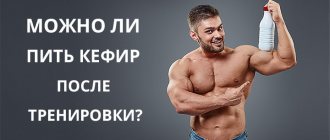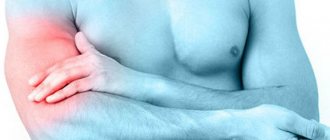What is lactic acid in muscles
During the process of evolution, the human body has developed several ways to provide muscles with energy. During normal muscle function, when the load does not exceed 50% of the maximum that the muscle can handle, glycogen (glucose) is broken down when interacting with oxygen, producing energy for the muscles in the form of ATP (adenosine triphosphoric acid).
If there is a lack of glucose in this mode, the human body gives preference to the process of breaking down fats to replenish it, therefore, when losing weight, it is recommended to work with light weights with a large number of approaches.
When the muscles are stressed, the mode of anaerobic (without oxygen) breakdown of glycogen is switched on, the rate of ATP formation rapidly increases, but during the reaction, lactic acid (lactate) and hydrogen ions are formed, sharply lowering the pH level, increasing the acidity of the environment.
An increase in the level of lactic acid leads to a burning sensation in the muscles and blocking their nerve endings, this is how the body’s defense system is activated, preventing severe damage to the muscles.
The chain of chemical reactions occurring in the body during the anaerobic decomposition of glucose is called the Krebs cycle.
This cycle is based on a sequential chain of transformations of glycogen into subsequent organic acids with their oxidation to carbon dioxide and water.
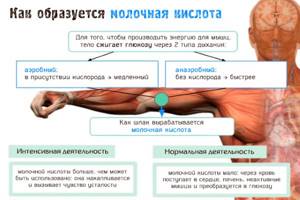
List of acids:
- pyruvic;
- lemon;
- glutamine;
- amber;
- formic;
- apple;
- dairy.
It has been scientifically proven that the launch of the anaerobic reaction of glucose decomposition is not associated with a lack of oxygen in the blood, but with a sharp increase in muscle load. At the same time, muscle cells do not experience oxygen starvation.
Don't miss the most popular article in the section: Laser hair removal on the face and body - how it is done, effectiveness, before and after photos, contraindications.
After which it appears
The human body produces lactate every time it receives energy by breaking down carbohydrates. When glucose and glycogen are broken down at an accelerated pace, lactic acid appears in large quantities.
The occurrence of muscle pain and cramps on the second or third day after exercise indicates deformation or inflammation of tissue fibers and overexcitation of muscle receptors, and not an excess of lactate. When lactic acid appears during training, a burning sensation is felt in the muscles when carbohydrates are broken down at lightning speed.
If you exercise slowly or finish your workout, the rate at which lactate is used for energy will match your performance.
The feeling of discomfort is not caused by lactic acid, but by its division into lactate and hydrogen. Experienced trainers know that lactate helps withstand stress, strain on the heart and serves as “fuel” for the liver. Without splitting into components, it is a harmless product.

Features of the synthesis and withdrawal of the substance
A chemical reaction that provides a sharp increase in the production of ATP to provide energy to muscle cells allows the muscles to cope with heavy loads. In this mode of operation, the muscles are subjected to serious overload and are injured. In the bodybuilding system, this effect on the muscles is used to trigger the supercompensation mechanism.
Damaged fibers are repaired and create additional muscle tissue. Thus, conditions are created to prevent the occurrence of micro injuries under such loads. Muscles grow and increase in volume.
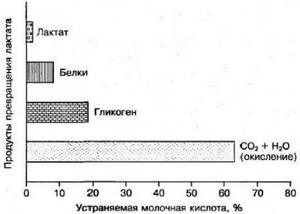
The result of anaerobic decomposition of glycogen is the appearance of lactate, which performs several important functions in the body:
- During the implementation of the Cori cycle, gluconeogenesis occurs in the liver, converting 20% of lactate into glucose.
- A high concentration of lactate in the muscles blocks nerve endings, preventing the muscles from contracting, causing a burning sensation in them, protecting the muscles from significant overloads.
Lactic acid in muscles is intensively processed by the body within an hour after physical activity.
What processes allow you to remove excess lactates and reduce muscle pain:
- Approximately 60% of the substance is converted to carbon dioxide and water during the oxidation reaction.
- The process of gluconeogenesis uses 20% lactate.
- A small part of the substance is used by the body for the synthesis of amino acids.
- Less than 5% is excreted in sweat and urine.
It is important to know! Increasing the intensity of training leads to an increase in blood lactate levels.
Reasons for the accumulation of lactic acid in tissues
There are several reasons for the increase in lactic acid levels in the muscles and circulatory system:
- High level of physical activity intensity. Glucose in the body is broken down without oxygen to form lactate.
- The rate of lactate formation exceeds the level of its removal from body tissues.
- In hemorrhagic shock and acute left ventricular failure, these are severe diseases of the circulatory system, characterized by a sharp decrease in the level of oxygen in the blood and the supply of blood to the liver; the concentration of lactic acid increases by 2-3 times.
Signs of excess substance in muscles
An increased lactate content in the muscles of the human body is manifested by the following symptoms:
- involuntary, convulsive muscle contraction occurs;
- when performing the exercise, a burning sensation appears in the muscles;
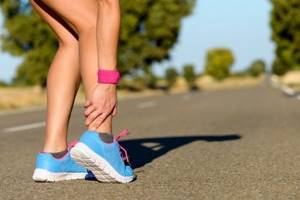
- severe fatigue is felt in the muscles, the speed of their contraction will decrease;
- After exercise, body temperature rises.
Advice! Drinking plenty of fluids during training helps maintain optimal blood circulation and normalizes pH levels in the muscles.
Pain during exercise
Every person has lactic acid in the muscles (how to remove it from the muscles, so the tips given later in the article will help you train without pain). The principle of supercompensation shows that for muscles to grow, they must be loaded in such a way that microtraumas occur in them.
This allows you to achieve an increase in muscle mass. Unfortunately, any damage to the body is accompanied by pain.
An athlete faces two types of pain during training:
- Burning sensation in the muscles when the muscles are overloaded.
- Acute pain from injured muscle tissue, joint or ligament.

The best option for allowing muscles to develop harmoniously is to alternate hard workouts with gentle ones.
During heavy exercise, micro-injuries occur in muscle tissue, and gentle exercise allows the muscles time to recover and strengthen. When performing exercises with weights, the athlete already after 20-30 seconds. begins to feel a burning sensation and pain in the muscles, this is how the appearance of excess lactic acid in the muscles manifests itself.
During this process, a substance called lactate is formed - a salt of lactic acid and hydrogen ions. Painful sensations arise precisely from the acidification of the environment through an increase in the concentration of hydrogen cations. They also prevent the passage of nerve impulses to the muscles, causing them to feel tired. This is how the body’s defense system against overload is implemented.
Advice! For better muscle development, when performing the exercise, you should concentrate on the rhythm of your breathing. You can't think about pain, you need to focus on the benefits and feeling of satisfaction from the workout.
Symptoms
When lactic acid is formed, it is immediately felt by the body in the form of pain in the muscle tissue. Sometimes after a difficult workout it can even be difficult to walk and roll over in bed. The muscles that have been most involved in physical activity experience particularly severe pain. For example, after exercises on the legs, the quadriceps and hamstrings will hurt.
It is important to finish your workout correctly
Obvious symptoms of this phenomenon will be increased fatigue, a feeling of “overwhelm” and even a feverish state. This condition can last up to 5 days, but usually goes away on its own. But sometimes an excessive amount of lactic acid can lead to rupture and damage to muscle fibers, so special measures and procedures are designed to get rid of these sensations.
It is also worth remembering that feeling tired during training does not always lead to pain later. However, if there is severe burning and discomfort during exercise, you should stop training or reduce the load so as not to damage the muscle fibers.
Delayed pain syndrome
Krepatura is the scientific name for delayed onset muscle pain syndrome. It appears one or two days after the lesson in beginners who are not involved in the training process, or in professionals who have undergone hard, intense training.
The cause of sore throat is the appearance of micro injuries in muscles that are not ready for such loads.
It is part of the process of muscle tissue adapting to overload. This process allows the muscles to recover and undergo hypertrophy (increase in muscle volume).
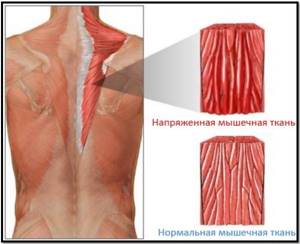
The delayed effect of pain is due to the fact that when receiving micro injuries, swelling of the damaged tissue occurs and a decrease in the sensitivity of nerve endings. As a rule, after a day the swelling is relieved and the sensitivity of the nerves is restored.
To prevent and relieve acute symptoms, you can use:
- Light aerobic training with light weights or cardio training.
- Cold and hot shower.
- For severe pain, you can take aspirin.
Advice! If you increase the load and activity of training by 10% per week, you will most likely be able to avoid the effect of delayed pain.
Don't miss the most popular article in the section: Morning exercises for those over 40, 50. Gymnastics exercises for weight loss, video lessons.
How to quickly lose muscle. How to remove inflated calves on your legs with exercises in a week?
Many women are dissatisfied with the size of their legs or legs in general and dream of reducing their calves even through surgery. But is this really the only way?
In fact, there are less expensive and dangerous methods that you can use:
- Do not walk on your toes, as this will strain your shins. A high heel maintains muscle tone, and this promotes responsive growth, like any activity associated with toning the legs, be it ballroom dancing, or even jumping rope. Everything is individual. For some, jumping and dancing will result in a decrease in the volume of the lower leg, for others - an increase. Track the results with a measuring tape and don’t panic;
- Run to reduce the thickness of your legs. Running is a powerful weight loss tool, but it's worth comparing the physiques of short- and long-distance runners. Athletes who run marathons have thin legs, while sprinters have powerful thighs and calves. Long distance running on flat terrain, at low speed and without acceleration is the answer to the question of how to remove fat from calves and legs in general;
- Avoid activities that require development of stamina, power and leg speed - this leads to muscle growth. For example, short intense cardio workouts, running on hills and incline treadmills, and jumping jacks build large calf muscles in response to exertion;
- Avoid intense jumping, including jumping rope, in interval training. Swimming, walking, cross-training, and the elliptical machine can all help you lose weight in your calves. Walking lengthens the muscles between the back of the knee and ankle. Avoid steppers, as they pump up the calf muscles;
- Resistance training can be kept as part of an active lifestyle, but use light weights and high repetitions. If you need to eliminate fat around the calf muscles, you will need to limit carbohydrates in your diet and increase the amount of cardio;
- Stretching makes the leg muscles longer and slimmer - stretching, yoga and Pilates classes are recommended for everyone who wants to become fit without building up calf muscles.
Where and how is the substance removed?
Human muscle tissue consists of two types of fibers: glycolytic and oxidative. Fast glycolytic fibers provide powerful muscle performance in a short period of time. They are the most powerful and voluminous in the human body. Slow, oxidizing fibers, small in volume, provide long-term work with low load.
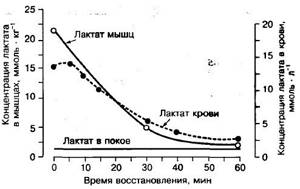
The energy for the work of these muscles is, among other things, lactate. They convert it into carbon dioxide and water. Thanks to this process, spending active rest after training helps to greatly reduce the level of lactate in the human body.
Up to 90% of lactic acid is broken down and eliminated by organisms after exercise in 1 hour.
About 60% of lactate goes to provide energy to slow muscles. Chemical reactions of the Cori cycle in the liver during the process of gluconeogenesis restore glycogen from lactate, 20% of the substance is involved in this process. Lactic acid is also used by the body to create amino acids. Only 5% of lactate leaves the body through sweat and urine.
According to one version of scientists, an increase in the amount of lactic acid affects the production of the hormone testosterone, which ensures muscle growth. When lactate was administered to experimental rats, their testosterone levels doubled. It follows that a balanced, heavy workout helps increase testosterone and allows you to quickly increase the volume of muscle tissue.
What to do if it already hurts
We are all human and we start looking for information when something has already happened =) It happens that some muscle group already hurts because the other day you worked out well and slightly overdid it, so you can’t walk, sit, lie down, etc. .P. =) Below there will be a block about stretching exercises for different muscle groups.
What to do if your abs hurt after a workout
Do abdominal stretching exercises. There are only two such exercises in my arsenal. I do them immediately after abdominal exercises.
Everyone knows about the “Bridge” exercise. Stand on the bridge and breathe with your stomach, inflate it as much as possible. Stay at the top point for about 20 seconds, then return to the starting position, and so on 3 times.
Exercise Bridge performed by me
It happens that I cannot stand on the “Bridge” because it is very dirty. For this I have a second exercise in a standing position. Clasp your hands and raise your arms up, and then place them behind your back. Start pulling your arms up and back, while pulling your tailbone down.
My execution of an abdominal stretching exercise
There are times when for some reason your abs don’t hurt after a workout, although you feel like you’ve really hammered them. There is an explanation for this phenomenon. There can be two cases:
- If you are new to training and have been doing it relatively recently, everything is simple, you just haven’t kept up. For the next workout, do it a couple of times and I can’t do it anymore. When you can’t do it anymore, then do it a couple more times. You will be in pain the next day. But in general, it’s better not to worry about why you need this discomfort; it’s better to increase the pace gradually.
- If you have been training for a long time and no matter how hard you try to hammer your abs, it doesn’t hurt no matter what you do. Here, too, everything is simple, if we take the third hypothesis as a working version. To test this hypothesis, stop doing abdominal exercises for 49 days. Then do the exercises that you did before on the abs, just don’t go crazy, I can’t do it the last time, they are very important. Share your results in the comments, I'll be waiting =)
What to do if your calves hurt after training
I only use one exercise. Approach the vertical support, lift the toe of your foot up and bring your heel as close as possible to the support. Warm up the calf with gentle rocking motions for about 30 seconds. Then fix your leg in the maximum stretched position for 10 seconds, and so on three times.
This is how I stretch my calves
What to do if your knees hurt after training
Guys, you urgently need to go to the doctor, it’s not normal when your knees hurt, don’t self-medicate!
What to do if your lower back hurts after training
Light running helps me, it not only helps my lower back, but also releases it, as well.
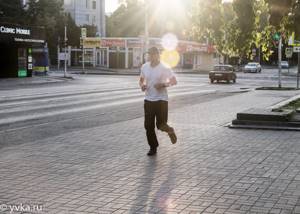
Morning running
What to do if your back hurts after training
The latissimus muscle may hurt in your back; to stretch it, stretch your arms above your head and bend at the waist. Grab the horizontal support at chest level, maybe lower. Then begin arching your spine. You should feel the latissimus muscle, this will signal that you are doing everything correctly. At the beginning, it is difficult for beginners to feel the correctness of the exercise, because... they cannot feel the muscle that they have never trained, they simply do not feel it, but they feel pain. Just do this exercise intuitively, in the future you will learn to feel all your muscles.
What to do if your joints hurt after training
Rotational exercises clockwise and counterclockwise. You just need to start the rotations slowly. Start with the wrists, then the elbows, then the shoulders. Do 50 times for each joint. Then move to the lower body. Rotational movements of the pelvis with increasing amplitude. Then move on to rotation of the knee joints and feet.
How to remove lactic acid from muscles: effective methods
The use of a special training system to restore normal muscle tone after intense physical activity is called a “cool-down.” Powerful strength training pumps more blood into your muscles.
With a sudden removal of the load and relaxation of the muscles, it will take a lot of time for the blood to renew itself in the overstrained muscles and reduce the level of lactic acid and toxins in them. To cool down, you can use light jogging, brisk walking, or yoga. The complex should be completed with stretching exercises for large muscle groups.
Stretching the muscles allows you to relieve spasms and restore optimal blood circulation in them. Lactic acid in muscles (how to remove excess lactates will be discussed later in the article) is produced during intense physical activity.
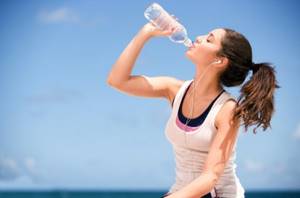
Regular exercise will allow the body to develop a high level of adaptation to physical training and will ensure a decrease in the level of lactic acid production. Every 20 minutes of exercise, drink 200 ml of clean water. It helps normalize blood circulation.
Between approaches, take proper rest to ensure restoration of breathing and heart rate.
When doing strength training, choose the weight of the projectile so that you can do 2-4 repetitions. This will ensure muscle development using aerobic energy sources. On days off from training, it is necessary to perform exercises with cardio load; they will ensure active blood circulation and accelerate muscle recovery.
Bath and sauna
A visit to the sauna will not only give you a boost of energy, but will also speed up blood circulation in the muscles, relieving fatigue and restoring muscle tone. To increase the effectiveness of bath procedures, certain rules should be followed.

The bath will help remove lactic acid from the muscles.
| Rules | Description |
| 1 | The first entry into the steam room is preparatory, it is done to warm up the body, it lasts about 10-15 minutes. The first sweat should appear on the skin. |
| 2 | Breaks between visits should be 5-10 minutes. |
| 3 | The duration of the second and third visits is 20 - 30 minutes. |
| 4 | At the end of the third run, it is best to steam yourself with an oak or birch broom. |
| 5 | Between visits, be sure to drink hot tea or herbal infusion. |
Advice! Diving into the pool or taking a cold shower after the steam room perfectly tones the worked muscles and is very invigorating.
Is it necessary to remove the acid?
As already mentioned, the pain is not caused by the presence of lactate in the muscles, but by the injuries caused during its elimination. And many people think that this is normal and endure unpleasant sensations without taking any measures. However, you cannot always endure; sometimes you need to take action. You should endure pain after a good workout in the following cases:
- If it does not affect the general condition (no fever, headache, etc.).
- Burning sensations do not affect the athlete in any way.
- The main goal of training is to build mass.
In these cases, you can simply endure it and not take any action. Many experts in this field and doctors argue about whether it is necessary to take any measures to neutralize lactate. Some are of the opinion that the body itself must remove this substance from the body. Some believe that it is necessary to take special medications or tablets to remove and get rid of excess salt. However, no harm was found from neutralizing the salt. Therefore, those who do not want to endure pain and discomfort can remove lactic acid on their own.
Hot bath
Lactic acid in the muscles (the following advice will help both remove its excess and reduce muscle pain) is eliminated under the influence of high temperature, so it can be eliminated with a hot bath. It is necessary to fill the bath with hot water at a temperature higher than comfortable, but not too scalding. Immerse yourself in water, keep your chest near your heart above the water level, relax for 10 minutes.

Get out of the bath for 5 minutes. Add hot water and soak in it for 15 minutes. 3 – 4 sessions will provide excellent warming up of the whole body. After all procedures, take a contrast shower. During breaks, restore water balance with hot or herbal tea.
Advice! When taking hot baths, it is necessary to turn on the exhaust ventilation. This will help reduce air humidity and increase the comfort of this procedure.
Drinking fluids during and after workouts
The human body is made up of 80% water, so staying hydrated ensures excellent health and good mood. For people leading an active lifestyle associated with physical activity and profuse sweating, it is necessary to consume at least 3 liters of water.
Water normalizes and optimizes blood circulation, thereby ensuring the removal of toxins and lactic acid from the muscles during training. When playing sports, the norm is to drink 200 ml of fluid every 20-30 minutes.
Advice! Using decoctions of rose hips, chamomile and licorice will quickly remove inflammatory processes in the muscles and relieve pain.
Massage
Kneading and pinching muscle tissue dilates capillaries and increases blood flow to the muscles. Professional massage allows athletes to recover much faster. Self-rubbing the body after water procedures with a terry towel will also increase blood flow in the muscles and allow you to get rid of the elements of glucose breakdown much faster.

Advice! The effectiveness of the massage will increase if you apply diluted essential oils of lavender or clary sage to the surface of the skin.
Rules for organizing training
Lactic acid in the muscles (you won’t need to think about how to remove excess lactates if you follow the recommendations during exercise) and muscle pain can be prevented by adhering to special training rules.
Rules:
- Before class, be sure to do a warm-up; it will warm up and prepare the muscles for stress and reduce the likelihood of injury.
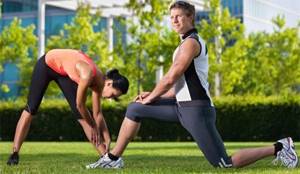
- After training, perform exercises from the cool-down complex.
- Increase the load gradually, no more than 10% per week.
- The rest between sets should allow breathing to recover, but allow the muscles to cool down.
- Alternate weight training with cardio. This allows you to intensively use slow muscles and reduce the level of lactate in the muscles.
- Exercise regularly, ensuring the body adapts to the stress.
- When doing strength exercises, do 2-4 repetitions, ensuring aerobic muscle nutrition.
- After training, rest in an active mode, loading the slow muscle fibers.
- Maintain a high level of water balance.
Advice! Using grapes, cherries, and blue cabbage in food will raise the level of antioxidants in the blood and ensure the effective removal of catabolic products (decomposition, oxidation) from the body.
How to remove muscles on the legs above the knee. Why do calves become voluminous?
So, among the common reasons are:
- Fat deposits. It's no secret that accumulations of fat can appear in a certain part of the body not only for genetic reasons. If its concentration is quite high, most likely the calves will also suffer from this. In addition, experts have proven that the specific features of the placement of fat accumulations depend on the presence of any diseases and on psychological factors.

Hereditary factor. If many of your relatives have large, strong and fleshy calves, most likely this problem has been passed on to you through heredity. In this case, it will be especially difficult to fight it. It is important to perform a series of complex exercises aimed at fully working out the problem area.
If the key reason is being overweight, the first thing you need to do is reconsider your lifestyle and start working hard on yourself. Then you should choose a suitable set of exercises to combat excess weight, which helps improve blood circulation in the calf area, as well as actively burn fat. In addition, you will have to perform a lot of aerobic exercise, evenly burning fat throughout the body. These include running, jumping and others. We must not forget about adjusting the diet - if the level of calories consumed exceeds the calories consumed, weight will only increase. To solve the problem, it is enough to limit yourself in nutrition.
Women can pump up the muscles in their legs when playing professional sports, where they have to load the muscles of the lower leg. We are talking about short distance running or individual strength exercises.
If you are interested in the question of how to remove muscle mass in the calf area, try to reduce the level of stress on the calf muscle as much as possible. It is better to replace short sprints with cross-country, and strength exercises with weights, which cause an increase in muscle volume, can be completely excluded from the sports program, adding classes to burn excess fat deposits.
Prevention of muscle pain
In order to prevent the occurrence of muscle pain after physical activity, several principles should be followed:
- You need to get involved in the training process, it should become a useful habit.
- At the first stage, you should work with light weights, you need to work out the correct technique for doing the exercises.
- Classes must be conducted regularly, without absences.
- Before training, you should prepare your muscles for stress by warming them up by doing a warm-up.
- When mastering a new exercise, try to do it with incomplete amplitude.
- Every 20-30 minutes of exercise you need to drink 200 to 250 ml of liquid.
- The duration of the workout should be increased gradually, starting from 30 minutes.
- You should follow the rules of a balanced diet, consume complex carbohydrates, complete proteins, vitamins and microelements.
- It is necessary to include in the diet carrots (carotenes), lemon (vitamin C), blue cabbage and eggplants (flavonoids), which will provide the body with the necessary antioxidants that remove waste products and toxins from the human body.

- At the end of the workout, you must do exercises from the cool-down complex. Muscle stretching exercises relieve excess tension and restore blood flow in them.
- After training, you should rest actively, visit the sauna, swim in the pool, ride a bike, and take walks.
- Adequate sleep will allow muscle tissue to be restored in the shortest possible time and will not allow muscle pain to appear.
Following the above recommendations will quickly remove lactic acid from the muscles, reduce excess lactate levels and make the training process enjoyable and painless.
Article design: Oksana Grivina
If your muscles hurt after training, can you exercise the next day?
Need to! But just train other muscle groups. Those that hurt should not be bothered, let them recover.
I mainly have pain in different muscle groups in my legs because... My job is sedentary, you rotate your body and arms at least somehow, and most of the time your legs are static. The other day I started doing a new exercise for myself “Lunges”, I had never done it before. My muscles were very surprised when I gave them such a load =) When you do some new exercise, you don’t immediately notice how tired your muscles are, and when you notice, it’s too late. It’s always like this with me, no, in order to do a little and calm down, I hammer until the last minute, and then I suffer.
Well, in short, the next day I barely crawled out of bed, the pain was so hellish, I moved in small steps =) When you have such pain, it’s clear that you don’t need to exercise, listen to your body . The next day, it was also painful, but it was easier, and the main thing here is not to feel sorry for yourself, but to force you to go train. I ran and after about three minutes I was pleasantly surprised, the pain almost went away, although towards evening it appeared again, but not so strong.
The conclusion is that stretching or light exercise on the muscles that hurt you helps relieve the pain, although not for long.


